 The basic concepts of steering in cars has remained unchanged for a very long time, based on the 'Ackermann' principle that first appeared in Germany more than two centuries ago.
The basic concepts of steering in cars has remained unchanged for a very long time, based on the 'Ackermann' principle that first appeared in Germany more than two centuries ago.
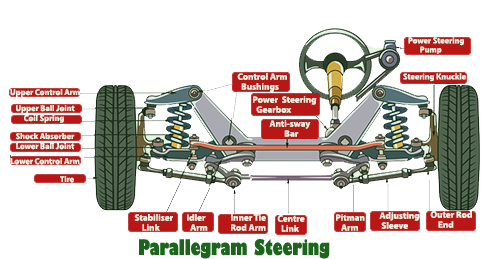 Ackermann proposed that when a vehicle is in motion, its axle should remain static, while at the same time its wheels should rotate on so-called 'steering knuckles,' which turn on a kingpin, a kind of pivot.
Ackermann proposed that when a vehicle is in motion, its axle should remain static, while at the same time its wheels should rotate on so-called 'steering knuckles,' which turn on a kingpin, a kind of pivot.
In the years before the rack-and-pinion steering system was introduced, vehicles were fitted with a parallelogram steering linkage system.
The idler and steering arms make up a rectangle in this system, changing to a parallelogram as the front wheels turn.
While the parallelogram had its advantages over its predecessors, it still was sadly lacking, sluggish, unresponsive and mechanically problematic.
Without a reasonable alternative, parallelogram steering remained the default steering system for many years until the mid-Fifties when rack and pinion steering began to be fitted on medium sized vehicles produced in the UK and Europe.
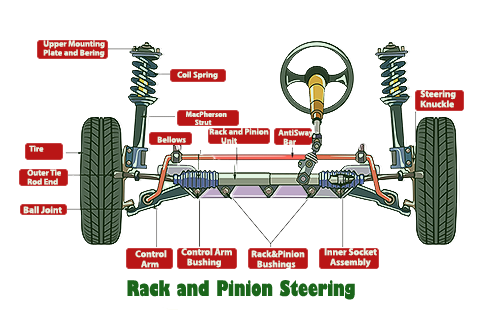 The principal behind rack and pinion steering that made it so attractive is the system of gears designed to take maximum advantage of the vehicle's steering ratio.
The principal behind rack and pinion steering that made it so attractive is the system of gears designed to take maximum advantage of the vehicle's steering ratio.
The steering ratio roughly translates into how much the driver will need to rotate the steering wheel to make a turn.
For example, a complete revolution (360 degrees) means the car's wheels turning a total of 20 degrees, making for a steering ratio of 18:1 (360 divided by 20).
Before the arrival of rack and pinion steering making any kind of turn was a long and laborious process, sometimes taking as much as four full complete revolutions to make a 360 degree turn.
With rack and pinion steering, that number was reduced considerably ( depending on the length of the vehicle.)
For the longest of times, it appeared that rack and pinion steering was the best system that car owners could hope for. The biggest drawback with this option was the especially heavy steering in tight spaces, such as parking. Owners of large saloons and estate cars suffered immensely from this severe shortcoming.
However, an end to their discomfort was coming over the horizon in the form of power steering, developed by the US car manufacturing giants during the late Sixties in the UK and Western Europe.
![]()
While upgrading to power steering meant a considerable capital layout, the investment was justifiable to many car owners with the dramatic improvement in steering control and the eminently more comfortable ride.
Over the years, advancements in power steering technology have increased the manoeuvrability and quality of ride in even the largest and most cumbersome of vehicles to a very high standard.
Upgrading a rack and pinion steering system to be hydraulically powered instead of manually is relatively straightforward.
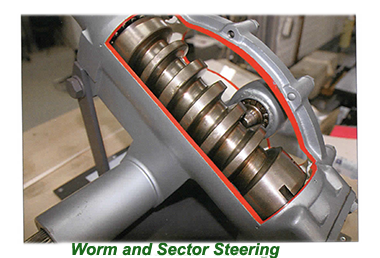 All that is required is fitting a hydraulically powered steering pump driven by a belt and pulley attached to the engine.
All that is required is fitting a hydraulically powered steering pump driven by a belt and pulley attached to the engine.
Many restorers, especially those working on a large and heavy saloon or estate, consider upgrading the vehicle to power steering, prepared to forsake authenticity for improved driver comfort.
Fitting a power steering system is not as easy as it looks, and only restorers with the necessary experience and specialist equipment should consider taking it on.
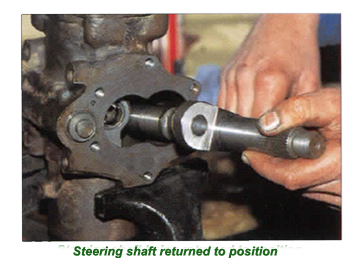 When considering a classic car for restoration, obviously its steering system should be looked at closely, while a simple test drive should be enough for the buyer to pick up on most problems before settling on a final price.
When considering a classic car for restoration, obviously its steering system should be looked at closely, while a simple test drive should be enough for the buyer to pick up on most problems before settling on a final price.
During a test drive, one of the first faults that is liable to stand out is if the steering begins to "wander." It may be a minor problem involving tyre wear that can be rapidly eradicated.
If the alignment appears to be stable and there's no excessive wear in the tie rod ends or the pitman arm, then there is a fair chance that the entire steering rack may need to be replaced.
Another common symptom of an ailing steering system is when the steering appears to jam when the vehicle is in motion momentarily, and the steering wheel is in a straight line.
This situation is known as "Dead spot" and can be alarming to the driver as, when they turn the wheel, the steering feels that it has become disconnected.
The steering does re-connect as rapidly as it has disconnected, but it remains a harrowing experience even then.
![]()
Discovering a dead spot is a sure symptom that the gears have worn out, usually meaning that the entire unit will likely need to be repaired or replaced without delay.
A vehicle that has been fitted with power steering has its own set of problems, usually involving a shortage of brake fluid.
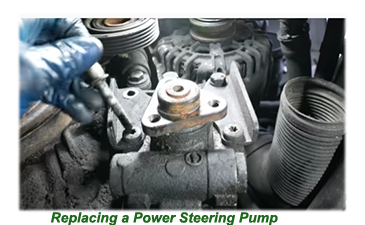 That's why it is a good idea to check the reservoir and the hydraulic fuel levels to make sure they are in order.
That's why it is a good idea to check the reservoir and the hydraulic fuel levels to make sure they are in order.
Without any half measures, the reservoir should always be full, and the hydraulic fluid should be light brown in colour and free from any signs of imperfections.
If the fluid level is lower than it should be, it must be fully topped up, while if there are any significant signs of contamination in the brake fluid the system should be fully flushed and new fluid added.
 Another sign that all is not as it should be wuth hydraulic fluid is that bubbles begin to appear- a sign that air could be getting into the system, probably by way of a cracked hose.
Another sign that all is not as it should be wuth hydraulic fluid is that bubbles begin to appear- a sign that air could be getting into the system, probably by way of a cracked hose.
The leak must be traced and the faultyt hose replaced.
One of the first tell-tale signs of leaking brake fluid is a bulid up under the vehicle.
In any case, the first place to check is the fluid reservoir, as there may be a leak there.
 If that is the case, a simple weld can usually do the job, although if the leak is found to be serious, then the entire reservoir might need to be replaced.
If that is the case, a simple weld can usually do the job, although if the leak is found to be serious, then the entire reservoir might need to be replaced.
Another cause for concern that can come up when testing is when a distinct smell of burning begins to rise up from the vehicle's underside.
This alarming phenomenon is almost certainly caused by steering rack overheating, usually due to a shortage of fluid in the reservoir, caused by a leak or a blockage.
Take me back to the home page.
ub5


